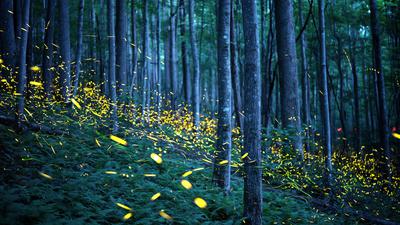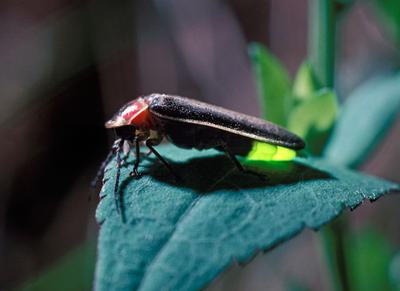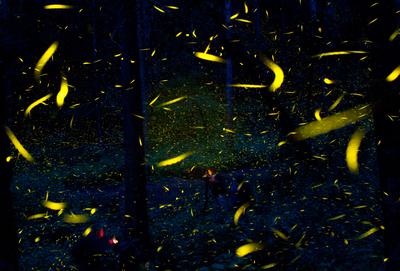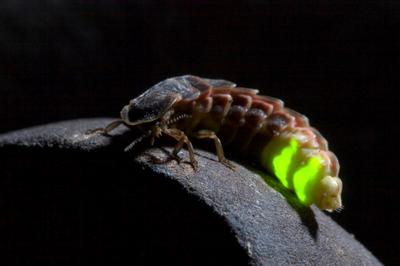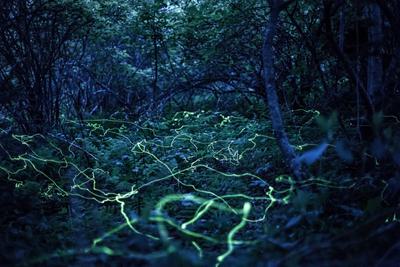For millions of people around the globe, fireflies have been a big part of the magic of spring and early summer nights. They certainly were in our family. When my children were young, our field in central Massachusetts blazed with fireflies.
Before our firefly expeditions in the 1980s I’d recite “All About Fireflies All About,” in which David McCord celebrates “little lanterns sailing by, like stars across a mimic sky.” We would catch fireflies in butterfly nets, and Scott and Beth would keep them in glass jars by or in their beds. The following morning I made sure they released them where we caught them. In 2023 I saw three fireflies in our field.
Children should pursue fireflies early and often. Never will they forget coursing through high grass, sweeping little lanterns from that mimic sky.
Fireflies (beetles, not flies) exist on every continent save Antarctica. There may be as many as 2,400 species, and new ones are being discovered. As the adult season winds down in the North American autumn, it starts or is ongoing elsewhere. The larval season is continuous everywhere.
Yet some firefly populations are in trouble. Evidence so far is mostly anecdotal. Still, in North America alone, the Firefly Specialist Group of the International Union for Conservation of Nature (IUCN) has identified 18 species as “at risk of extinction.”
New LED streetlights, touted as environmentally friendly, appear to be disrupting reproduction of Britain’s glow-worms.
The gravest threat is habitat destruction. This from Ben Pfeiffer, founder of the educational group Firefly Conservation & Research: “I live in one of the fastest-growing areas in the nation — between Austin and San Antonio, Texas. Firefly habitat is being converted to dense development at a ridiculous rate. Each year thousands of acres disappear.”
Water pollution has been responsible for much decline, especially in Asia where larvae of many firefly species are aquatic. And in the southeast part of the continent, razing mangroves to make way for shrimp farms and palm-oil plantations is killing off Pteroptyx firefly species as well as the snails the larvae prey on.
A Thai boatman who grew up with fireflies along the tidal rivers of Bangkok estimates firefly populations there have dropped 70 percent. “I feel like my way of life is being destroyed,” he told Sara Lewis, a retired Tufts University biology professor who now co-chairs the IUCN Firefly Specialist Group and is the author of a book about fireflies, Silent Sparks.
Forests in Brazil and Mexico, which have some of the richest firefly diversity, are losing populations to clearcutting and fragmentation.
An eastern firefly, also known as a big dipper, the most common firefly species in North America. E.R. Degginger / Alamy Stock Photo
Pesticides and lawn chemicals are major limiting factors. Mosquito spraying kills nontarget insects including fireflies. And homeowners douse their lawns with all manner of elixirs deadly to firefly larvae and their prey, both of which live in soil and leaf litter.
Most fireflies use species-specific flash codes to find mates. But light pollution blinds the flying males so they can’t find the females. And the sedentary females (in some species they’re wingless) can’t move to darker areas.
New LED streetlights, touted as environmentally friendly, appear to be disrupting reproduction of Britain’s glow-worms. The male’s eyes are tuned to the female’s green light, but under the LED blue light males struggle to find females.
Fireflies produce cold light by oxidizing luciferin with the enzyme luciferase, useful in food-safety trials and biomedical research. Starting in 1947 McElroy’s Lab in Baltimore sponsored firefly harvesting, paying children 25 cents per hundred, then snipping off the fireflies’ lanterns and hawking the contents. Soon McElroy’s was killing a million fireflies a year with no consideration for rare species. Other companies joined in. St. Louis-based Sigma Chemical Company, for instance, bountied fireflies of any and all species at a penny a piece as part of its “Firefly Scientists Club open to all Boy Scout groups, church groups, 4-H clubs, and individuals.” By the early 1990s, Sigma had killed “more than 100 million fireflies,” reports Lewis.
Firefly ecotourism has become a huge business. Taiwan’s and Mexico’s firefly shows each draw about 100,000 visitors a year.
But there’s good news, too. Since synthetic luciferase became available in 1985 the commercial slaughter has sharply diminished, and some populations are recovering. Firefly ecotourism has become a huge business, inspiring restoration. Taiwan’s and Mexico’s firefly shows each draw about 100,000 visitors a year, Malaysia’s 80,000.
The three groups of fireflies include: lightning bugs, flightless glow-worms, and dark fireflies whose eggs and larvae glow but whose adults lack lanterns and fly by day, locating mates by scent.
Larvae can live for two years. But most adults don’t live much more than two weeks. They mate abdomen to abdomen, coupled all night. Along with sperm, the male gives the female a “nuptial gift” — a protein package for egg production.
In the high country of Tennessee and North Carolina, some of the most spectacular fireflies light up in synchrony, with males flashing six times in rapid succession, then going dark for six seconds. Ground-based females respond dimly or with a double flash.
In 1991 Lynn Faust of Knoxville, Tennessee read an article in Science News proclaiming that there were no synchronous fireflies in the Western Hemisphere. But she’d been watching synchronous shows around her family’s cabin in Great Smoky Mountains National Park since the 1960s. She contacted the scientists quoted in the article and set them straight.
Today Faust is a member of the IUCN Firefly Specialist Group. The synchronous “light show” she introduced to the world now brings thousands of tourists to the park each June. About 30,000 applicants compete for 1,800 parking spots.
Around her farm in east Tennessee Faust is “surrounded by lightning bugs” — at least 26 species with such evocative names as Chinese lanterns that float close to the ground at twilight, heebie-jeebies that sparkle continuously from trees, blue ghosts (that emit blue, minute-long flashes and whose wingless females guard their eggs), snappy syncs (that light up synchronously), shadow ghosts, four flashers (that flash four times), sidewinders (that flash sideways), woodland lucys, little grays, winter fireflies, pink winkers, bush babies, and spring treetop flashers.
You can converse with most firefly species if you study their flash codes and imitate them with a penlight.
Spring treetop flashers appear early in the year. They can freeze solid, fall off a tree, then recover. Males hatch first, locate a female pupa, climb on top, and embrace her with their legs. Except to fight off rivals, the male never moves until the female emerges and they mate. Unlike the soil-dwelling larvae of other fireflies, these larvae climb trees, so they’re the only ones you’re likely to see pupate. They glue their tails to the bark and hang upside down, always on the tree’s south side.
Firefly larvae are voracious predators of snails, slugs, worms, and soft-bodied insects. But the general thinking is that adults don’t eat. It’s not true. Kids who catch fireflies can keep them alive longer if they drop a slice of apple in the jar.
In all life stages fireflies contain toxins that make them repugnant to predators. Larvae and eggs glow continuously, as a warning. And while no one has determined how fireflies acquire toxins, Faust has an idea. One day she was riding her horse through a milkweed field, and even from that high perch she saw so many fireflies on milkweed that she dismounted. They were clearly nectaring on the flowers, which like all parts of the plant, contain the cardiac glycosides that protect monarch butterflies from predators.
One group of fireflies, called femme fatales, can’t acquire toxins except by purloining them. The large females imitate the female flash responses of other species. When a male comes to mate, the femme fatale seizes him with her long legs and devours him. She will also pick off males in flight and steal fireflies from spider webs. Lewis, the IUCN Firefly Specialist Group’s co-chair, tells of how her nephew Nate, then five, was horrified one morning to see a pile of body parts in his firefly jar. “My fireflies got murdered,” he lamented. There was only one left, a bloated femme fatale.
On a family firefly expedition to our neighbor’s farm circa 1985 I flashed a penlight about once every six seconds. Each time a firefly on the ground 50 yards away responded with a single flash. I had no idea what that meant. I do now. I’d stumbled onto the male flash code of the big dipper (named for its dipping flash pattern), and a female was answering me.
You can converse with most firefly species if you study their flash codes and imitate them with a penlight. But bright light confuses fireflies, making them cease normal behavior. They’re tolerant of red light. So if you have to use a flashlight to find your way, cover it with red cellophane (available at art supply stores).
Japanese school children now raise fireflies and release them in proper habitat, and there are firefly festivals all over the country.
Alarm about firefly decline is inspiring recovery work. For centuries, fireflies have been central to Japanese poetry, art, and the Shinto belief that sacred spirits grace the landscape. But industrialization, agricultural runoff, pesticide contamination, and harvesting nearly wiped them out. Firefly hunters were selling their catch, sometimes 3,000 a night, to wholesale shops. From there the fireflies were bagged and delivered by bicycle courier to habitat-bereft cities where they were released for the public to enjoy and where they promptly died. That practice has been banned.
Japanese school children now raise fireflies and release them in proper habitat, and there are firefly festivals all over the country. Today Japanese fireflies are a symbol of environmental enlightenment and national pride. “While [they] have never been restored to their former glory days,” writes Lewis, “a predictably sad saga was transformed into a conservation success story by an impressive combination of national, local and private efforts.”
In the United States, recovery is just starting. “We’ve been spending lots of effort getting out in the field and hunting down old museum records to find out what populations are still around,” says Anna Walker of the New Mexico BioPark Society, who works with Lewis and Faust on IUCN’s Firefly Specialist Group. “We’re trying to learn what species need to be petitioned for Endangered Species Act protection.”
Blue ghost fireflies in the Blue Ridge Mountains of North Carolina, captured in a long-exposure photograph. Radim Schreiber
Petitions to the U.S. Fish and Wildlife Service were recently filed for the Bethany Beach firefly in Maryland and Delaware, the loopy five of Tennessee, Georgia, and South Carolina, the Florida intertidal firefly, and the Southwest spring firefly.
Firefly recovery depends heavily on citizen science. The Xerces Society has a program called Firefly Atlas where people can take online training and report trends in firefly populations. And the Firefly Conservation & Research has a habitat certification program that teaches how to grow firefly populations on private land.
One of the few sanctuaries in North America dedicated specifically to fireflies is in Connecticut — the Marvin, Massarella, & Friends Firefly Sanctuary managed by New Canaan Land Trust. But firefly sanctuaries happen by accident when people create, protect, or restore habitat. Butterfly gardens are also firefly gardens. In fact, almost all gardens produce fireflies because the rich soil attracts the prey of firefly larvae.
“As long as you can protect or restore their habitats, we’ve got a really good chance of reversing firefly declines.”
You can create a sanctuary by: eliminating outdoor lights or at least putting them on timers; reducing or eliminating pesticides and lawn chemicals; switching to natural fertilizers; planting native forbs, grasses, shrubs, and trees; keeping property moist by creating pools and water gardens; and, the easiest and most popular of all, resisting requests to mow grass and rake leaves.
“When there’s a will to protect species, we can be quite successful, especially with insects because they reproduce very quickly,” remarks Anna Walker. “As long as you can protect or restore their habitats, we’ve got a really good chance of reversing firefly declines.”
Our field in Massachusetts gets blighted by town mosquito spraying. But during the abysmal 2023 firefly showing, I had an epiphany. My family is part-owner of a 280-acre island on a New Hampshire lake. There are dozens of vernal pools, a stream, a pond, no outdoor lighting, no mowing, no raking, no use of pesticides or lawn chemicals. We’ve always had fireflies, but non-abundant forest species.
Three years ago we did extensive selection logging, planting native grasses in all the cutover spots. On July 12 I drove across the bridge at twilight, and the lush, new grasslands were blazing with fireflies — thousands of them. I felt like I’d been transported back to the 1980s. We’d created an accidental firefly sanctuary.
Correction, September 19, 2023: A previous version of this article stated that fireflies are tolerant of blue light. But recent research indicates they are most tolerant of red light. The article has been updated to reflect that finding.
